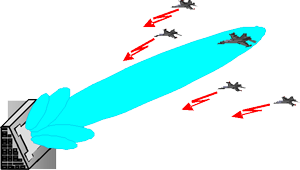Mathematical models of cross-correlated and uncorrelated Gaussian noise jamming from external sources
DOI:
https://doi.org/10.3103/S0735272721030043Keywords:
Gaussian noise jamming, cross-correlated jamming, intercorrelated jamming, uncorrelated jamming from external source, mathematical model, linear phased antenna array, planar phased antenna array, input sample, correlation matrix, amplitude phase distributionAbstract
This paper is devoted to the description of mathematical models of cross-correlated and uncorrelated Gaussian direct-noise jamming with uniform frequency spectrum produced by spatially-point external sources of noise radiation. They are designed for airspace control radars with spatially narrow-band linear equidistant phased antenna array (PAA) consisting of identical omnidirectional elements and also with planar or volumetric PAA. The use of the developed models allows researchers to generate the input (training) sample of the specified size using the pseudorandom number generators. This sample is formed by complex vectors, the components of which correspond to readings of complex amplitudes in spatial channels receiving at discrete time instants additive mixture of intrinsic noise and noise jamming from external sources with specified intensity and angular coordinates. The accuracy and adequacy of developed mathematical models have been proved analytically and checked by the method of mathematical experiments. The proposed models can be used for mathematical modeling in synthesis of adaptive radar protection systems with linear or planar and volumetric narrow-band PAA from Gaussian noise jamming and the analysis of their efficiency.
References
- Y. D. Shirman, S. T. Bagdasaryan, A. S. Malyarenko, D. I. Lekhovitskii, Radio Electronic Systems. Principles of Construction and Theory. Reference Book, [in Russian]. Moscow: Radiotekhnika, 2007.
- W. Liu, J. Liu, L. Wang, K. Duan, Z. Chen, Y. Wang, “Adaptive array detection in noise and completely unknown jamming,” Digit. Signal Process., vol. 46, pp. 41–48, 2015, doi: https://doi.org/10.1016/j.dsp.2015.07.006.
- S. Ahmed, F. Abbasi, U. I. Ahmed, “Radar jamming suppression using clipping based pulse integration,” in NAECON 2018 - IEEE National Aerospace and Electronics Conference, 2018, vol. 2018-July, pp. 587–591, doi: https://doi.org/10.1109/NAECON.2018.8556736.
- S. Zhouyan, W. Min, Z. Lu, M. Linzhi, “Research on track deception technology based on jamming of flexible lines by jammers,” MATEC Web Conf., vol. 176, p. 01039, 2018, doi: https://doi.org/10.1051/matecconf/201817601039.
- P. Addabbo, O. Besson, D. Orlando, G. Ricci, “Adaptive detection of coherent radar targets in the presence of noise jamming,” IEEE Trans. Signal Process., vol. 67, no. 24, pp. 6498–6510, 2019, doi: https://doi.org/10.1109/TSP.2019.2954499.
- C. Liu, R. Wu, Z. He, X. Zhao, H. Li, P. Wang, “Modeling and analyzing interference signal in a complex electromagnetic environment,” EURASIP J. Wirel. Commun. Netw., vol. 2016, no. 1, p. 1, 2016, doi: https://doi.org/10.1186/s13638-015-0498-8.
- V. P. Riabukha, “Adaptive radar noise jamming protection systems. 3. Mathematical model of the system of spatial signal processing in a radar with a rectangular planar PAA,” Appl. Radio Electron., vol. 15, no. 4, pp. 301–315, 2016, uri: https://openarchive.nure.ua/handle/document/12106.
- I. S. Reed, J. D. Mallett, L. E. Brennan, “Rapid convergence rate in adaptive arrays,” IEEE Trans. Aerosp. Electron. Syst., vol. AES-10, no. 6, pp. 853–863, 1974, doi: https://doi.org/10.1109/TAES.1974.307893.
- R. A. Monzingo, T. W. Miller, Adaptive Arrays. New York-Chichester-Brisbane-Toronto: John Wiley & Sons, 1980.


